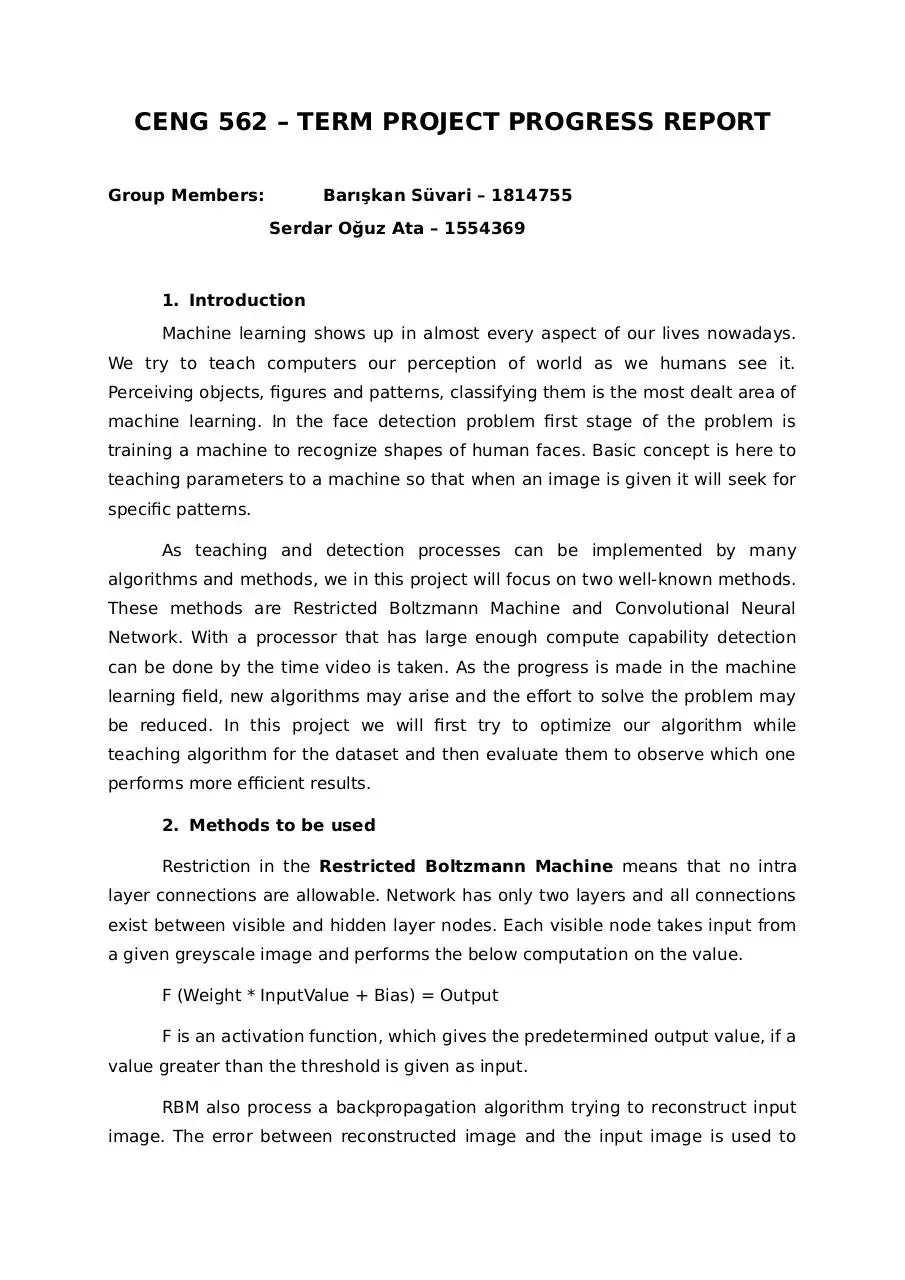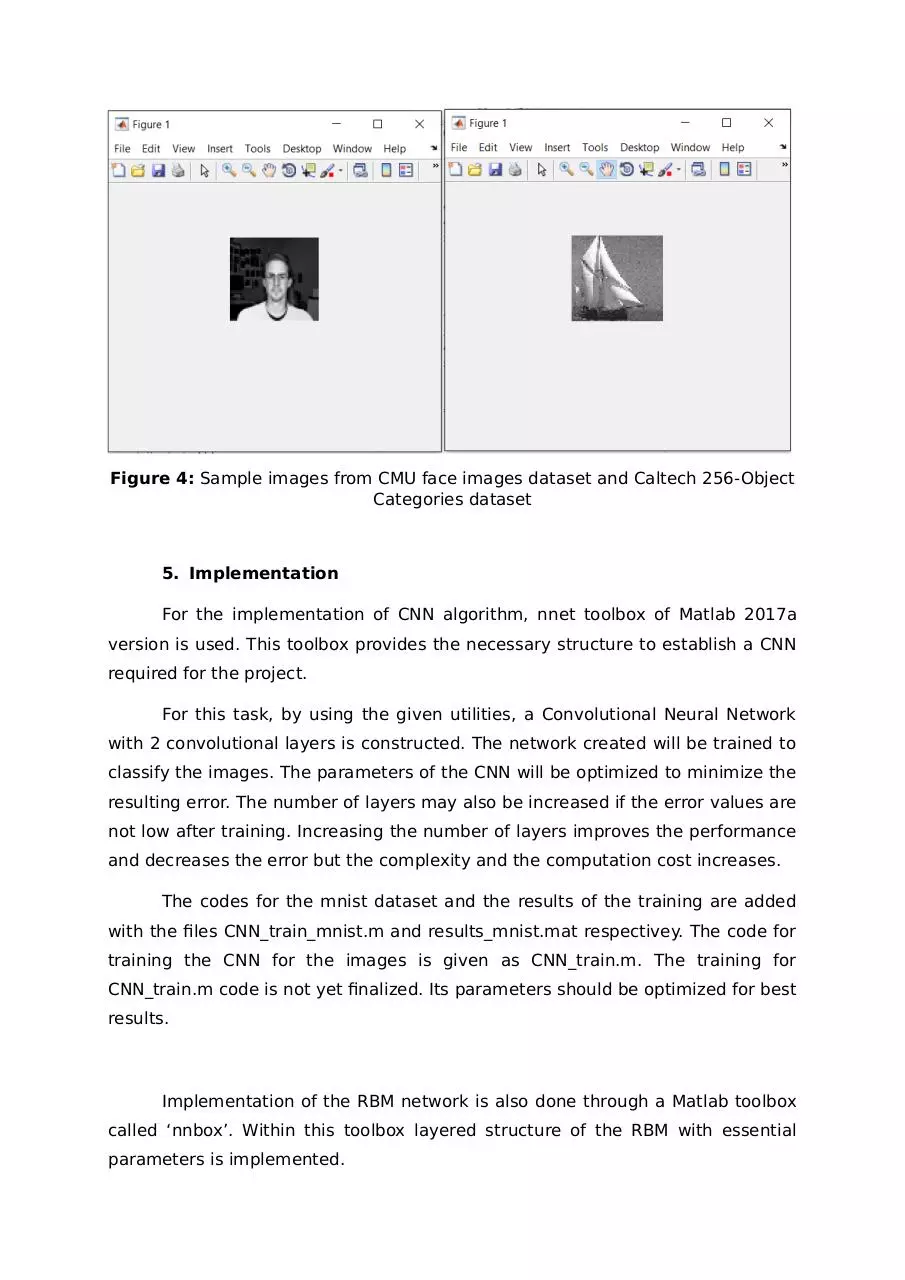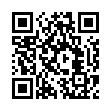Progressive Report (PDF)
File information
Author: Cemal Barışkan SÜVARİ
This PDF 1.4 document has been generated by Writer / LibreOffice 5.1, and has been sent on pdf-archive.com on 19/04/2017 at 05:01, from IP address 92.45.x.x.
The current document download page has been viewed 688 times.
File size: 567.63 KB (7 pages).
Privacy: public file





File preview
CENG 562 – TERM PROJECT PROGRESS REPORT
Group Members:
Barışkan Süvari – 1814755
Serdar Oğuz Ata – 1554369
1. Introduction
Machine learning shows up in almost every aspect of our lives nowadays.
We try to teach computers our perception of world as we humans see it.
Perceiving objects, figures and patterns, classifying them is the most dealt area of
machine learning. In the face detection problem first stage of the problem is
training a machine to recognize shapes of human faces. Basic concept is here to
teaching parameters to a machine so that when an image is given it will seek for
specific patterns.
As teaching and detection processes can be implemented by many
algorithms and methods, we in this project will focus on two well-known methods.
These methods are Restricted Boltzmann Machine and Convolutional Neural
Network. With a processor that has large enough compute capability detection
can be done by the time video is taken. As the progress is made in the machine
learning field, new algorithms may arise and the effort to solve the problem may
be reduced. In this project we will first try to optimize our algorithm while
teaching algorithm for the dataset and then evaluate them to observe which one
performs more efficient results.
2. Methods to be used
Restriction in the Restricted Boltzmann Machine means that no intra
layer connections are allowable. Network has only two layers and all connections
exist between visible and hidden layer nodes. Each visible node takes input from
a given greyscale image and performs the below computation on the value.
F (Weight * InputValue + Bias) = Output
F is an activation function, which gives the predetermined output value, if a
value greater than the threshold is given as input.
RBM also process a backpropagation algorithm trying to reconstruct input
image. The error between reconstructed image and the input image is used to
recompute weight and bias values. Each time these two processes are done RBM
tries to learn parameters for a better reconstruction. Processes done on layers of
RBM can be seen on Figures 1.
https://deeplearning4j.org/restrictedboltzmannmachine
Figure 1: Construction of the output and backpropagation phases of RBM
Convolutional neural networks are very similar to the Feed- Forward Neural
Networks in terms of architecture. Just like known neural networks CNNs are also
composed of neurons with weight and bias like parameters. An input comes to
the neuron weighted and biased with neurons parameters and then a non-linear
function creates an output from it. Because of down sampling property of CNNs
they are preferable compared to ordinary Neural Networks.
CNN architecture can be examined in 3 main layers, Convolution Layer,
Max Pooling Layer (Sub-Sampling Layer) and Fully Connected Layer.
Convolution layer performs dot product with a sliding window on a given
image. Each color channel is processed with different windows. Then all three
results are summed with bias and written to an activation map matrix. Stacked
sliding windows are also called as filter or kernel. Increasing the number of filters
allows examining more features.
At the end of convolution layer a ReLU(Rectified Linear Units) layer
might be added to perform an activation function thresholding at zero on the
obtained activation maps. This operation can be represented by the following
formula:
f(x)=max(0,x)
In Max Pooling Layer layer a down sampling operation will be done on
the matrix obtained from convolution layer. Main purpose in performing down
sampling is to decrease number of parameters and computation hardness. First a
filter size and stride is selected for down sampling operation. Then, just like in the
convolution layer, filter window moves on the matrix and takes the largest value
in the window. According to the selected filter size and stride a new matrix is
created and obtained max numbers are placed in according with the positions in
the previous matrix.
After computations of convolution and pooling layers, obtained results are
classified one label per node in the fully connected layer. Since the neurons in
this layer have full connections to previous nodes, activations are calculated by
multiplication of weights and sum of biases. In this way, from an original image,
class scores can be computed.
https://adeshpande3.github.io/adeshpande3.github.io/A-Beginner%27s-Guide-To-UnderstandingConvolutional-Neural-Networks/
Figure 2: Layers and operations of CNN
3. Overall Design
Overall project is based on the comparison of the two well-known machine
learning methods. As seen on the block diagram below, our path to follow on this
project begins with training both algorithms with selected datasets. We will try to
optimize parameters for both algorithms to obtain better results. Then, we will
compare their performances with respect to the performance metrics given
below.
Figure 3: Overall block diagram of the project
4. Dataset Characteristics
For train and test processes two datasets are used. These are CMU face
images dataset and
Caltech 256-Object Categories dataset. To avoid overloading on our computers
we choose to use
images with 60x64 pixel sizes and in greyscale. We choose 144 images from both
face dataset and
non-face dataset. Train and test operations will be done with these 288 images by
choosing random
batches. Two sample images from both datasets can be seen below.
Figure 4: Sample images from CMU face images dataset and Caltech 256-Object
Categories dataset
5. Implementation
For the implementation of CNN algorithm, nnet toolbox of Matlab 2017a
version is used. This toolbox provides the necessary structure to establish a CNN
required for the project.
For this task, by using the given utilities, a Convolutional Neural Network
with 2 convolutional layers is constructed. The network created will be trained to
classify the images. The parameters of the CNN will be optimized to minimize the
resulting error. The number of layers may also be increased if the error values are
not low after training. Increasing the number of layers improves the performance
and decreases the error but the complexity and the computation cost increases.
The codes for the mnist dataset and the results of the training are added
with the files CNN_train_mnist.m and results_mnist.mat respectivey. The code for
training the CNN for the images is given as CNN_train.m. The training for
CNN_train.m code is not yet finalized. Its parameters should be optimized for best
results.
Implementation of the RBM network is also done through a Matlab toolbox
called ‘nnbox’. Within this toolbox layered structure of the RBM with essential
parameters is implemented.
In RBM algorithm first the input images taken from datasets are read and
put into matrix forms with ReadImgs.m file. Since the traning is done in a
supervised manner, targetvalue matrix is also created. Then, first layer is created
in accordance with the input image sizes. Number of the input neurons in the first
layer is taken same as the total pixel sizes in the images. Hidden units in the first
and second layer can be changed to optimize performance. Then, the second
layer of the network is added to the network again with random parameter
values. To classify images in test phase as face and non-face on the output, a
simple perceptron with two output neurons is used. After creating overall network
structure, different parameter values will be tried for optimizing performance of
algorithm.
6. Evaluation of the Results
Training of CNN for images takes a long time. For now, the network is
trained using mnist dataset to recognize hand written digits. The code for this
task is added to the website. For this dataset, the accuracy of correctly classifying
the digits is 0.9812.
After training for the mnist dataset, CNN for images is constructed, but it is
not yet trained and the parameters are not yet optimized for this project. CNN is
a very efficient method for classification purposes, but training and optimizing
the parameters of CNN for images takes a long time.
As in the CNN, Mnist dataset has also been trained on RBM algorithm.
Before going further on the algorithm, we thought a well-known dataset like
mnist should be trained to observe faults. Training and testing classification
errors on the mnist dataset are obtained 0.0298 and 0.0343 respectively. Error
rate change in the training phase and classification error results can be found in
the ‘RBM_Mnist_Results’ file. After some work on the RBM algorithm we will be
able to train and test our selected datasets on the network.
7. Conclusion
In our point of view, we have made a huge progress in our project. Methods
to be implemented studied in detail. The layer wise structure of networks and
main blocks of the algorithms are constituted. On the other hand, exercising on
the mnist dataset showed us our faults in the algorithms and the parts we need
to focus on more. We will focus on these parts to implement better algorithms.
Also, we should include more performance measurement techniques while
evaluating the algorithms, like training time and CPU consumption.
8. References
http://cs231n.github.io/convolutional-networks/
http://deeplearning.net/tutorial/rbm.html
toolboxes:
http://www.mathworks.com/help/nnet/deep-learning.html
https://github.com/pixelou/nnbox
datasets:
http://kdd.ics.uci.edu/databases/faces/faces.data.html
http://authors.library.caltech.edu/7694/
Download Progressive Report
Progressive Report.pdf (PDF, 567.63 KB)
Download PDF
Share this file on social networks
Link to this page
Permanent link
Use the permanent link to the download page to share your document on Facebook, Twitter, LinkedIn, or directly with a contact by e-Mail, Messenger, Whatsapp, Line..
Short link
Use the short link to share your document on Twitter or by text message (SMS)
HTML Code
Copy the following HTML code to share your document on a Website or Blog
QR Code to this page

This file has been shared publicly by a user of PDF Archive.
Document ID: 0000585676.